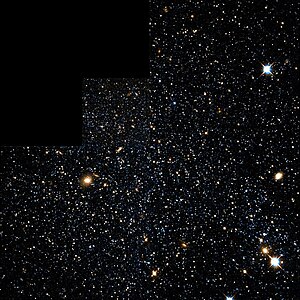| Revision as of 20:02, 28 March 2017 editCydebot (talk | contribs)6,812,251 editsm Robot - Speedily moving category PGC objects to Category:Principal Galaxies Catalogue objects per CFDS.← Previous edit | Revision as of 01:33, 22 May 2017 edit undoTheodolite (talk | contribs)Extended confirmed users1,905 edits add CMG nameNext edit → | ||
| Line 64: | Line 64: | ||
| | doi = 10.1086/182374 | | doi = 10.1086/182374 | ||
| | postscript = <!--None--> | | postscript = <!--None--> | ||
| }}</ref> It is currently 1.44 ] away from ]. Its name comes from the fact that it is part of the ]. | }}</ref> In the Catalogue of Named Galaxies, it is called '''Nivalis Phoenicis''', or the ''snowy'' galaxy.<ref>{{cite web|last1=Bodifee|first1=Gerard|title=Catalogue of One Thousand Named Galaxies|url=http://www.bodifee.be/wp-content/uploads/2015/08/2_CMG.pdf|accessdate=21 May 2017}}</ref> It is currently 1.44 ] away from ]. Its name comes from the fact that it is part of the ]. | ||
| == Characteristics == | == Characteristics == | ||
Revision as of 01:33, 22 May 2017
| Phoenix Dwarf Galaxy | |
|---|---|
 Phoenix Dwarf by the Hubble Space Telescope Phoenix Dwarf by the Hubble Space Telescope | |
| Observation data (J2000 epoch) | |
| Constellation | Phoenix |
| Right ascension | 01 51 06.3 |
| Declination | −44° 26′ 41″ |
| Redshift | 60 ± 30 km/s |
| Distance | 1.44 ± 0.07 Mly (440 ± 20 kpc) |
| Apparent magnitude (V) | 13.1 |
| Characteristics | |
| Type | IAm |
| Apparent size (V) | 4′.9 × 4′.1 |
| Notable features | - |
| Other designations | |
| ESO 245- G 007, PGC 6830 | |
The Phoenix Dwarf is a dwarf irregular galaxy discovered in 1976 by Hans-Emil Schuster and Richard Martin West and mistaken for a globular cluster. In the Catalogue of Named Galaxies, it is called Nivalis Phoenicis, or the snowy galaxy. It is currently 1.44 Mly away from Earth. Its name comes from the fact that it is part of the Phoenix constellation.
Characteristics
The Phoenix Dwarf has an inner part of young stars which is stretched in an east-west direction and an outer part of mainly old stars that is stretched north-south. The central region's rate of star formation seems to have been relatively constant across time (Martínez-Delgado et al. 1999). In 1999, St-Germain et al. discovered a H I region of about 10 M☉ just to the west of Phoenix. Its radial velocity is -23 km/s and may be physically associated with Phoenix if it is found to have a similar radial velocity.
References
- ^ "NASA/IPAC Extragalactic Database". Results for Phoenix Dwarf. Retrieved 2007-03-15.
- I. D. Karachentsev; V. E. Karachentseva; W. K. Hutchmeier; D. I. Makarov (2004). "A Catalog of Neighboring Galaxies". Astronomical Journal. 127 (4): 2031–2068. Bibcode:2004AJ....127.2031K. doi:10.1086/382905.
- Karachentsev, I. D.; Kashibadze, O. G. (2006). "Masses of the local group and of the M81 group estimated from distortions in the local velocity field". Astrophysics. 49 (1): 3–18. Bibcode:2006Ap.....49....3K. doi:10.1007/s10511-006-0002-6.
- Schuster, H.-E.; West, R. M. (May 1976). "A very distant globular cluster?". Astronomy & Astrophysics. 49: 129–131. Bibcode:1976A&A....49..129S.
- Canterna, R.; Flower, P. J. (March 1977). "A new dwarf irregular galaxy in the constellation Phoenix". Astrophysical Journal. 212 (Letters): L57 – L58. Bibcode:1977ApJ...212L..57C. doi:10.1086/182374.
- Bodifee, Gerard. "Catalogue of One Thousand Named Galaxies" (PDF). Retrieved 21 May 2017.
- van den Bergh, Sidney (April 2000). "Updated Information on the Local Group". The Publications of the Astronomical Society of the Pacific. 112 (770): 529–536. arXiv:astro-ph/0001040. Bibcode:2000PASP..112..529V. doi:10.1086/316548.
External links
- The Phoenix Dwarf on WikiSky: DSS2, SDSS, GALEX, IRAS, Hydrogen α, X-Ray, Astrophoto, Sky Map, Articles and images
| Milky Way | |||||||
|---|---|---|---|---|---|---|---|
| Location | Milky Way → Milky Way subgroup → Local Group → Local Sheet → Virgo Supercluster → Laniakea Supercluster → Local Hole → Observable universe → Universe Each arrow (→) may be read as "within" or "part of". |  | |||||
| Structure |
| ||||||
| Satellite galaxies | |||||||
| Related | |||||||